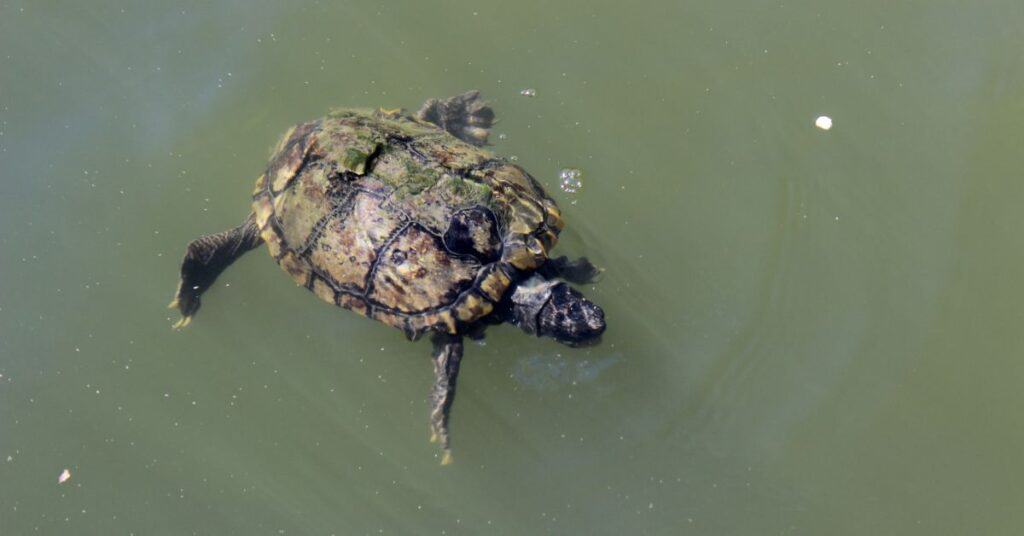Deirochelys reticularia (Chicken Turtle)
Home > Turtle Database > Deirochelys reticularia (Chicken Turtle)

Deirochelys reticularia is commonly known as the chicken turtle due to its long neck resembling that of a chicken. It’s a semi-aquatic species, often found in slow-moving waters and known for its distinctive reticulated shell pattern, which is where it gets its scientific name.
Native To These Regions
Alabama (USA), Arkansas (USA), Florida (USA), Georgia (USA), Louisiana (USA), Mississippi (USA), North Carolina (USA), South Carolina (USA), Texas (USA), Virginia (USA)Native Turtle Species Map – Find Turtles by Region
Scientific Classification
- Kingdom: Animalia
- Phylum: Chordata
- Class: Reptilia
- Order: Testudines
- Family: Emydidae
- Genus: Deirochelys
- Species: D. reticularia
Common Names
- Chicken Turtle
This Hilarious Turtle Book Might Know Your Pet Better Than You Do
Let’s be real—most turtle care guides feel like reading a textbook written by a sleep-deprived zookeeper.
This one’s not that.
Told from the snarky point of view of a grumpy, judgmental turtle, 21 Turtle Truths You’ll Never Read in a Care Guide is packed with sarcasm, sass, and surprisingly useful insights.
And hey—you don’t have to commit to the whole thing just yet.
Grab 2 free truths from the ebook and get a taste of what your turtle really thinks about your setup, your food choices, and that weird plastic palm tree.
It’s funny, it’s honest, and if you’ve ever owned a turtle who glares at you like you’re the problem—you’ll feel seen.
Identification
- Description: Chicken turtles have an elongated, reticulated carapace with yellow lines forming a net-like pattern. Their heads are small, with a long neck covered in yellow stripes, distinguishing them from other turtles.
- Sexual Dimorphism: Females are generally larger than males, with males having longer and thicker tails.
Native Origin and Distribution
- Geographical Range: Found primarily in the southeastern United States, from Virginia to Texas, typically in coastal plains and southern wetlands.
Preferred Habitat
Chicken turtles inhabit slow-moving, freshwater habitats such as ponds, marshes, and swamps, often preferring areas with abundant aquatic vegetation.
Behavior
- Feeding Habits: They are omnivorous, feeding on aquatic invertebrates, small fish, and plants.
- Predators: Predators include raccoons, large birds, and alligators.
Reproduction
- Breeding Season: Breeding typically occurs in the fall and winter, a unique trait compared to other turtles.
- Reproductive Method: Females lay eggs in sandy soil near water sources, with clutches typically consisting of 5–15 eggs.
Conservation
- Extinction Status: Least Concern (IUCN).
- Threats: Habitat destruction, pollution, and road mortality.
- Conservation Measures: Protected in some states, habitat restoration efforts are being pursued.
Economic Importance
Chicken turtles have minimal economic importance but are sometimes kept as pets due to their unique appearance.
Interesting Facts
- Chicken turtles are one of the few turtle species that actively hunt prey by extending their long necks quickly to capture it.
- They are capable of aestivation, burying themselves in mud during dry periods.

About Author
Muntaseer Rahman started keeping pet turtles back in 2013. He also owns the largest Turtle & Tortoise Facebook community in Bangladesh. These days he is mostly active on Facebook.











